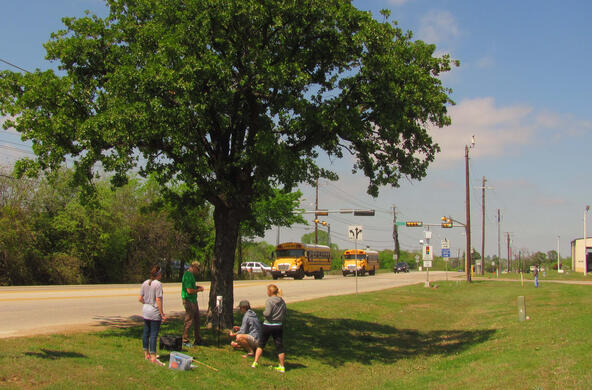Many wild animals can carry COVID-19, including those that live among us, such as deer mice, red foxes, white-tailed deer, and more. These species may act as reservoirs, offering new opportunities for the virus to mutate and spill back into people. The omicron variant, for example, is thought to have emerged from mice.
With $3 million in federal grant funding, a new five-year research project will bring together virology, disease ecology, and artificial intelligence to better understand how SARS-CoV-2 (the virus that causes COVID-19) behaves in natural ecosystems, to anticipate strains with the potential to spread widely between people and animals. The award comes from the U.S. Department of Agriculture Animal and Plant Health Inspection Service through the Ecology and Evolution of Infectious Diseases program, a joint effort of the National Institutes of Health, National Science Foundation, and the National Institute of Food and Agriculture.
“In order to know the risk that new variants pose for people, we really have to figure out how SARS-CoV-2 is moving through mammalian wildlife,” explained Barbara Han of Cary Institute of Ecosystem Studies, who will co-lead the new project with Andrew Kramer from the University of South Florida. The project will also assess risk of spillover from people to wildlife, and how new strains could impact ecological communities.
Whereas most current disease surveillance methods collect existing variants and try to pick out the most concerning ones, the new project will use artificial intelligence to predict future variants that don’t yet exist but could be problematic if they emerge. This will generate a surveillance watch-list for the public health community.
“That way, if we find one of these in the wild, we’ll know that we should sit up and pay attention,” said Han.
Because the strategy is proactive instead of reactive, it has the potential to shift the paradigm for how society monitors and manages SARS-CoV-2 transmission in animals, said Kramer.
The project is divided into four parts. Step 1 will use AI to create a library of future strains of SARS-CoV-2 with predicted high zoonotic potential, or the ability to infect both people and animals. In order to do this, the AI will be trained on the sequences and protein structures of past strains.
Step 2 will predict which animals may be susceptible to the variants identified in Step 1, and therefore could serve as potential hosts. Scientists know that SARS-CoV-2 enters mammalian cells through the ACE2 receptor. However, ACE2 receptors are slightly different in every species, and haven’t been studied in the vast majority of mammals. To overcome this dearth of data, the team will use artificial intelligence to predict the structure of ACE2 receptors in various species, and whether or not the variants could bind to the receptors and infect the cell.
Payel Das at IBM Research will lead the AI development needed for Steps 1 and 2. “IBM Research is proud to assist in the prediction of coronavirus transmission between wildlife and humans through the latest cutting-edge AI technologies, including generative AI and foundation models,” said Das. “Ultimately, we hope this work can lead to critical insights that will enable us to better prepare for future human health threats.”
Step 3 is where the AI predictions get tested on real cells in a lab. Virologist Michael Letko of Washington State University will engineer parts of the virus strains identified in Step 1, and see if they actually bind with ACE2 receptors in cells from humans and a subset of the animals identified in Step 2. Results will be used to retrain the AI and further improve the predictions of Steps 1 and 2.
“This part of the study is where we will move from concept to concrete,” said Letko. “Making predictions on a computer is one thing, but to actually see how those predictions perform in a physical and biological context will help us truly understand if our models are accurate.”
He added that since the experiment only uses a small piece of each virus sequence — just the part that binds with the ACE2 receptor on the outside of the cell — there is no potential for it to actually cause an infection, replicate, or spread in any way.
In Step 4, the team will draw on 30 years of environmental monitoring at Cary Institute to simulate a Northeastern forest environment to understand how SARS-CoV-2 moves through real ecosystems where many species are differentially susceptible to infection.
Viral outbreaks in most wild populations are under-observed, with estimations of the curves they follow mostly theoretical. By drawing on field data, the team will use models to account for how wildlife interacts in nature, where you can have multiple infected species interfacing via competition, predator-prey relationships, or other forms of contact.
“By connecting potential variants and their performance in lab assays to species interactions in the real world, we can better understand the real implications of SARS-CoV-2 being spread to many different species at the same time,” said Kramer, who will lead this portion of the study.
Understanding these dynamics should help to improve assessments of risk to wildlife and people, and help predict spillover into humans, said Kramer — not only for SARS-CoV-2, but for other types of animal-borne diseases as well, such as avian influenza.
The team hopes that their results will inform surveillance efforts, for example by identifying potential host species that need to be managed or by immediately sounding the alarm when one of the strains predicted to be a threat pops up in the wild.






